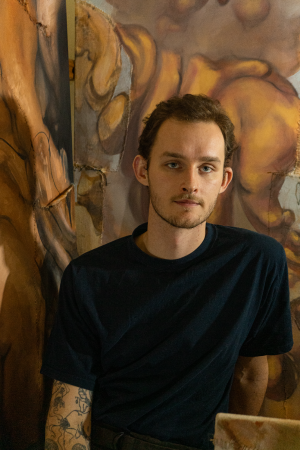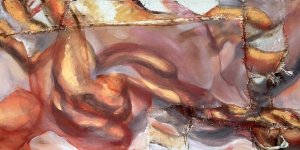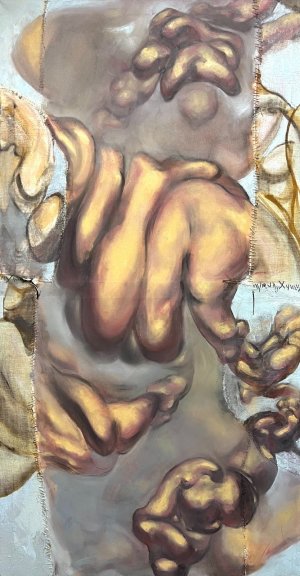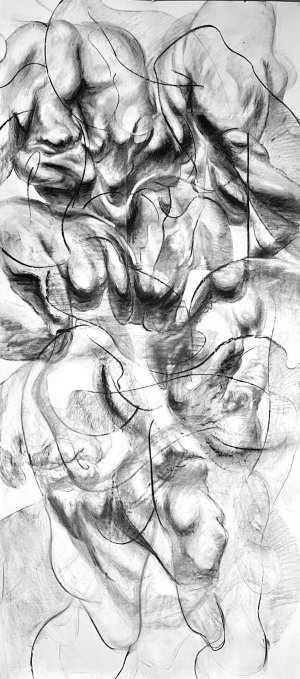In the first edition of the A4 Zine in 2024, we have featured three incredible artists. One of whom is Kubo Mlynarčík – an emerging painter. In this interview, Kubo shares insights into his artistic process, influences, and future aspirations. Join us as we uncover the inspiration behind his creations. Kubo’s art is on the display in A4 throughout June of 2024.

Kubo Mlynarčík, a young artist currently studying at the Academy of Arts in Banská Bystrica, shares his journey from the vibrancy of graffiti art to the captivating canvas of painting. Growing up in a small village, Kubo’s passion for creativity was ignited through the rebellious appeal of skateboarding, graffiti, and alternative music. However, he chose to immerse himself in the world of art which ultimately propelled him towards studying art. Embracing the opportunity to explore various artistic approaches, he found his true calling in painting during his third year of studies, drawn to its immediacy and boundless expressive potential. Through his artistic journey, Kubo continues to break barriers and embrace the endless possibilities that painting offers for self-expression and creative exploration.
A4 Zine is created by the international volunteers of A4 who are here through the European Solidarity Corps (ESC), funded by the European Union.
Can you tell us a bit about yourself and your artistic journey as an emerging painter in Slovakia? How did you find your passion for art, and what led you to pursue painting as your medium of expression?
My name is Kubo Mlynarčík. I am studying at the Academy of Arts in Banská Bystrica. My art journey started with graffiti. I grew up in a small village and my dream was, paradoxically, to experience the adventures of a city. I rode a skateboard, I did graffiti, and I listened to alternative music. I found it impossible to study art in high school, so I decided to be a graphic designer and drew in the evenings. At the end of high school, I decided that I wanted to go to the Academy of Arts. I got lucky because 16 people were accepted to the printmaking department that year, not 12 as usual. The academy gave me a lot, I was trying new approaches every semester, breaking down my barriers to creativity. In my third year, I discovered that printmaking was not a medium through which I could express myself as quickly as I wanted, so I switched to painting. I knew I could express myself directly in painting without an emphasis on technology. It opened new possibilities for me.
What inspires you to create art and who (and what) are some of your artistic influences?
I think it’s the drive to improve in my personal life as well. I try to seek and address my childhood traumas to be able to experience everyday life even better. To be able to feel more, to not be numbed by learned defenses. I am also inspired by my memories, psychology and psychoanalysis. Visually, I am very inspired by the multiple-layered glass of the windows on trains and buildings. The layered reflections in them. Reflections that create a kind of dynamic of ordinary moments and new patterns. I was strongly inspired by Jenny Saville, from whom I later moved on to Francis Bacon or the sculptor David Altmenjd. But I am also inspired by Hans Bellmer’s disturbing dolls. I also look up to Sainer, a Polish artist who is like a colorist god to me, and of course to the old masters, especially Rubens.
„I want to become more free. To improve my visual language through painting and add some paste to it and be more expressive.“
How would you describe your artistic style and the themes you explore in your work?
My style follows the wave of contemporary surrealism. Also, I lean strongly towards symbolism through the connection of materials and colours with other symbols and metaphors. I am a figurative artist, so my natural form of expression is figure. I deal mostly with retrospective, autobiographical and social themes.
As you continue your artistic journey, do you foresee any shifts or developments in your stylistic approach? Are there any techniques or aesthetics you’re interested in exploring in your future work?
I want to become more free. To improve my visual language through painting and add some paste to it and be more expressive. I also plan to create some spatial objects and installations in the near future. Some will possibly include participatory approaches. I’d love to learn sculpting as well and free forms will no longer be just painted interpretations. I am currently painting free forms, to prove their existence, but in the future, I would like to make them move and capture how full of life they are.
Could you elaborate on the technical aspects of your painting process? What techniques do you employ to achieve qualities and visual impact present in your artworks?
My process starts with the selection and collection of potential materials. Items that will evoke some kind of emotions in me, and bring some memories to the surface. I have often been referred to by teachers as a draftsman, so the drawing appears in my work in different forms. Whether in the form of a charcoal drawing, or an oil drawing that refers to the style of the old master’s studies. And more recently in the form of seams that resemble scars and open wounds. In the working process, I enjoy the materiality, the rawness, and the texture. I currently work in the medium of oil painting, however, I build the image with a sculptural mindset. Layering and shaping the material. I often use models from pornography, it’s a source of various twisted bodies, in sometimes primal situations.
„What draws me to the theme of freedom is the desire to free myself. The desire to heal the wounds created by my past. Also to free myself from the political situation, over which I have no control.“
Your work explores themes of freedom, memory, and the human experience. What draws you to these themes, and how do you approach their depiction in your work?
What draws me to the theme of freedom is the desire to free myself. The desire to heal the wounds created by my past. Also to free myself from the political situation, over which I have no control. The need to create human images is a reaction to the digital age we live in. I can’t be better than artificial intelligence or paint perfect pictures that can be photographed. I can create human images, with flaws, with human touch, with its own skin.
How do memories and aura of a certain place influence your creative process and the themes you then explore?
I think good art has to have a dose of authenticity. The materials help to connect the viewer with the place where I grew up. To show the comfort of home through the bed sheets, the rawness of village life thanks to jute. And to connect my current work with the past and my ancestors‘ handwoven linen that is in some cases up to 100 years old.
What are some of the challenges and opportunities as an emerging artist in Slovakia? How do you see the contemporary art scene in Slovakia evolving, and what role do emerging artists like yourself play in shaping its trajectory?
The big challenge is to make yourself visible. To be published, to exhibit in galleries and to make a living from art in general. In today’s cultural situation in Slovakia, it will probably be difficult to even tell and stand up for the truth. There is a visible diversity of styles and themes in the contemporary Slovak scene. There are a lot of artists following today’s trends, but there are also many inspiring artists worth mentioning, for example, Tereza Mazúrova with her punk sculptures, Mikey Sketcher’s (Michal Laurinc) interpretation of Dobšinsky’s fairytales in brutal comic book creations, Kiki Kerekešova with her free-crocheted esoteric objects. I think new artists are just cooking their artistic styles, which will shape the whole scene of modern art history in the future, just like it happened in the past.
Looking ahead, what are your aspirations and goals as an artist? How do you see your artistic practice evolving in the future?
I want to be seen. I want to have a space to create without obligations, to have my own agenda and to make a living from art. There is already an artistic community in my town, where it is a joy to create and meet other artists. I want to make spatial pieces, large-scale paintings and drawings. When I have the opportunity, in the distant future, I would like to teach. I enjoy creating and thinking about the range of possibilities that appear in the process.
What exciting projects or exhibitions can we look forward to from you in the near future? How do you plan to continue pushing the boundaries of your artistry and engaging with audiences both locally and internationally?

I will be a part of several group shows this summer. I will be a part of a new exhibition concept “Ťažisko” in Prešov. At the end of August, I will be a part of Park Camp in Trebišov, for which I have prepared a work in public space, that will reflect the current situation with prostitution in Trebišov. My last year in the master’s degree at the academy is ahead of me and with it my thesis. This means you can look forward to a lot of new works and big-scale works!

